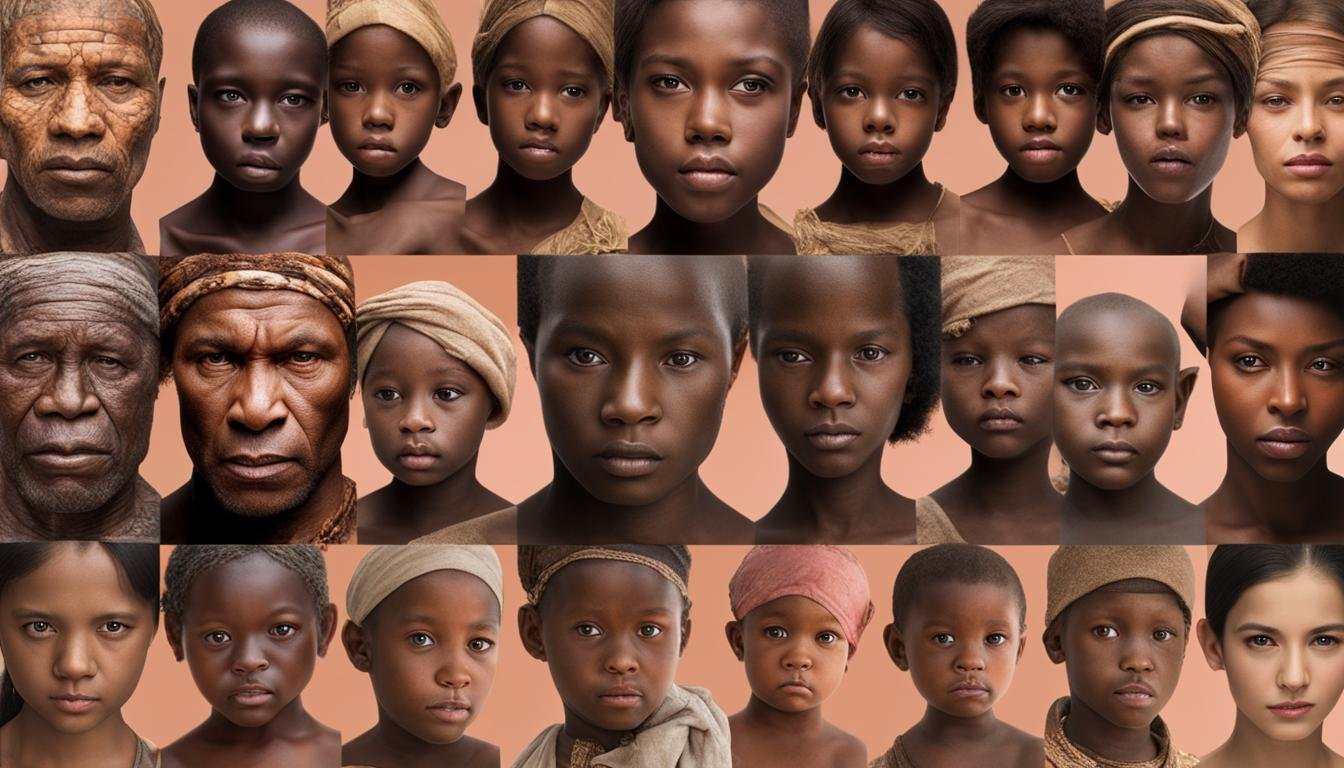What was the first skin color of humans?
Have you ever wondered about the origins of humanity’s diverse complexions? It’s fascinating to think about how our skin color evolved throughout our evolutionary history. So, let’s dive into the science behind it and explore the factors that influenced the first skin color of humans.
Key Takeaways:
- Humans inherit their skin color from their ancestors through biology and genetics.
- Research suggests that skin color was an evolutionary response to changes in UV radiation exposure.
- The production of melanin, a pigment that acts as a natural sunscreen, played a crucial role in the development of different skin colors.
- Differences in skin color are primarily regulated by genetic variations in melanin production and distribution.
- The evolution of skin color is a result of genetic adaptations to changing UV radiation levels and migration patterns.
The Science Behind Skin Color
The actual skin color of humans is influenced by various factors, with the main determinant being the pigment melanin. Melanin is produced by melanocytes, and its production and distribution in the skin are regulated by genes. Different genetic variants control the amount and type of melanin produced, resulting in the wide range of skin tones observed in humans.
The genetic mechanism behind skin color is primarily regulated by the enzyme tyrosinase, which creates the color of the skin, eyes, and hair. Differences in skin color are also attributed to variations in the size and distribution of melanosomes, the structures within melanocytes that contain melanin. Melanin plays a vital role in protecting the skin from UV radiation, but excessive exposure can still lead to health problems.
Therefore, the evolution of different skin colors is a result of genetic variations and adaptations to environmental factors such as UV radiation.
Did you know that the actual skin color of humans is influenced by various factors? Melanin, a pigment produced by melanocytes, plays a central role in determining our skin color. But how is it regulated?
Genes are responsible for controlling the production and distribution of melanin, resulting in the wide range of skin tones observed in humans. The main player in this genetic regulation is the enzyme tyrosinase, which creates the color of our skin, eyes, and hair. Additionally, variations in the size and distribution of melanosomes contribute to differences in skin color.
These genetic variations and adaptations to environmental factors, such as UV radiation, have led to the evolution of diverse skin colors. While melanin protects our skin from harmful UV radiation, excessive exposure can still have detrimental effects on our health.
Evolution of Skin Color
The evolution of human skin color is a fascinating process influenced by natural selection and migration patterns. As early humans migrated away from the equator and encountered different levels of UV radiation, their skin color adapted to their new environments.
Darker skin tones emerged as a protective adaptation against intense sunlight in tropical regions. Melanin, the pigment responsible for skin color, acts as a natural sunscreen, shielding against harmful UV rays. The high melanin content in darker skin provides greater protection, reducing the risk of sunburn, skin damage, and skin cancer.
On the other hand, lighter skin tones evolved in areas with lower UV radiation levels. In these regions, there was a greater need for increased vitamin D production, as sunlight exposure was less intense. Lighter skin allows for better absorption of UVB radiation, which is essential for the synthesis of vitamin D in the body.
To illustrate the correlation between sunlight exposure and skin color variation, research by Nina Jablonski and George Chaplin found that skin tone correlates with surface-level UV radiation. This supports the theory that natural selection played a significant role in shaping the diversity of skin colors we observe today.
In addition to natural selection, migration patterns also contributed to the evolution of skin color. As humans migrated to different regions with varying levels of UV radiation, their genetic makeup adapted to the new environment over thousands of years. This adaptation allowed for optimized protection against excessive UV exposure and adequate vitamin D production, contributing to better overall health.
Tanning, a temporary adaptive response to UV exposure, further demonstrates the interplay between genetics, migration, and environmental factors. When exposed to UV radiation, the skin produces more melanin, resulting in a darker complexion. This increased melanin production serves as a protective mechanism against further damage from UV rays.
The evolution of skin color is a complex and dynamic process, shaped by natural selection, migration, and the need for protection against UV radiation. It highlights the remarkable adaptability of human beings and the intricate relationship between genetics and environmental factors.

| Factors | Effect |
|---|---|
| Natural selection | Leads to the development of darker skin tones in regions with intense sunlight and lighter skin tones in areas with reduced UV radiation levels |
| Migration | Humans adapt genetically to new environments, optimizing protection against UV radiation and promoting vitamin D synthesis |
| Sunlight exposure | Influences melanin production and vitamin D synthesis, driving the evolution of skin color |
| Tanning | Temporary darkening of the skin as a protective response to UV exposure |
Conclusion
The analysis of genetic variants associated with skin pigmentation in Africa reveals the complexity of skin color evolution. We now understand that the existence of lighter and darker skin variants challenges the notion of fixed traits based on race. Skin pigmentation in humans is a result of multiple genetic factors and is not indicative of superiority or advancement.
It is fascinating to note that pale skin variants actually predate the appearance of Homo sapiens and have been retained in certain African populations. This suggests that shared ancestry plays a significant role in skin tone variation. For instance, the discovery of shared light skin alleles between the San population and archaic hominins supports the idea of a common lineage for this trait.
The existence of a wide range of skin tones across Africa underscores the diversity within the continent and debunks the notion of a homogeneous “African race.” Understanding the genetics and evolution of skin color helps debunk racist ideologies and leads to a more inclusive view of human diversity. It reminds us that our shared ancestry connects us all, regardless of skin tone or physical appearance.






